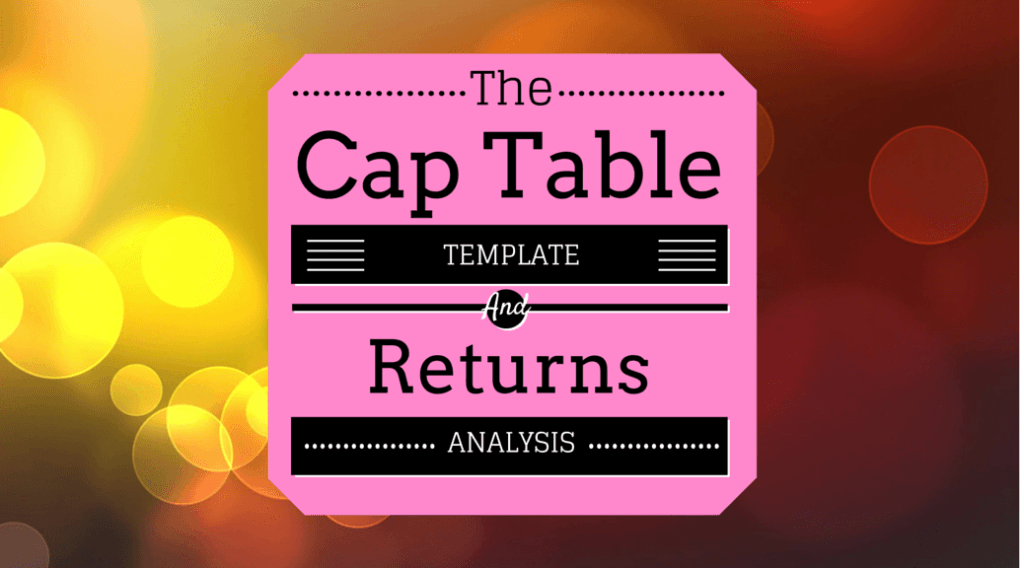Tl;dr: FREE cap table example! Learn how to read a cap table and manage it with a free cap table excel template to manage and track the capitalisation of your company. Manage your convertible note, seed round and series-a as well as ESOP option pool with this excel calculator.
Who owns what’s in your startup?
If you are bootstrapped and making it work. Dude, hats off! You rock! You don’t need to really care about your ownership structure.
But… If you are like 99% of founders today who are building or hoping to build a VC investor funded startup, then I’m sorry!
Your cap table matters and this is why I am here, to show you how to create an ultimate startup cap table example and return analysis template
If you don’t care, that’s fine. But the moment you start talking to investors you will very quickly realize that the only thing investors care about is how much they own. They know that from your cap table.
Download the cap table example here
- Confirm your email
- The cap table will download in your browser and save to your downloads folder
What is a cap table?
It is an excel spreadsheet that shows the pro forma ownership of your startup in a ledger at different periods of time. It is a list of the shareholders and how much each person owns. It tells you how much money you will make if you exit, which is what I am sure you want to know!
Also read: ‘Why’ you are making a financial model for your fundraise is wrong
Why do you need a capitalization table?
Think of it this way, when you start out as a founder you own 100% of the company, right? Well, you raise a Seed round and now investors have a chunk. How do you know who owns what? The cap table tells you.
Furthermore, by having one properly set up, you can truly understand what you own in different scenarios, even after all sorts of complex things like effects of liquidation preferences, discounts on convertible debt, the option pool shuffle happens. More importantly, it helps you to not confuse ‘basic’ stuff like your ownership being based on post-money valuations and not pre-money.
A cap table is something that every startup needs, but something no one really knows how to do. Furthermore, there is an implied expectation that founders have one and know how to do them.
As an investor might say to a founder “Send me your cap table over this evening will you?”, with the founder saying “Sure!” only to go back to the office and say to their co-founder, “what the hell is a cap table?”
There is actually a pretty hilarious episode of the TV series ‘Silicon Valley’ entitled “The Cap Table” that goes exactly as above. Sensing the ignorance of the startup, Peter Gregory (the VC), goes into shock, exclaiming to his Associate, Monica, “What did I buy?”
He then goes on demanding a cap table and business plan from Richard (the protagonist of the series).
Richard doesn’t know what it is and goes to Wikipedia to find out:
If you stare at an investor with a pale, blank face when questioned ‘what does your cap table look like?’ you can be pretty sure that what comes next will not be super auspicious.
FML. Cap table calculations.
Trust me, I know.
A couple of years ago I was just like you. I didn’t know anything about cap tables. Well, I knew something about them, just not much. I saw some super simple venture hacks model and their video, but frankly, that’s so ghetto simple. It seems like you know it all… but you really don’t.
Whether you want to do some basic stuff, or are a dap hand and know all the stuff most don’t know they don’t know… you can do it now.
Intro video to cap table
Here is an intro video to the new cap table
Live example of filling in cap table
Here is me thinking out loud and filling out a cap table for an imaginary startup, taking you step by step
Finally, if you want to get your dirty mittens on the FREE cap table model, put your email below and the model will be emailed to you!
What will you get (for free)?
- Template, filled in cap table
- Blank cap table to start using
Ok, here is the box to get the model:
Why won’t the price per share calculate?
I’m sick of people asking… you don’t have iterative calculations turned on. Watch:
Some more reading:
- Convertible note conversion math at Series-A. You don’t know how it really works!
- Key convertible note terms that no one understands and cost you big
- Seed round convertible, priced and SAFEs. What venture capital terms are standard?
- Understand how to read fully diluted shares and total outstanding stock in a cap table
- What does the cap table template look like?
The sheets in the cap table
You input all the shareholders here.
This drives the drop down menus
All the calculations that happen in the background are in this sheet
All your common, seed, series-a cap tables are in this sheet
All your staff go in the ESOP ledger
You input all the terms for your convertible note investors in this ledger. You choose what round they will convert into
Your common ledger manages your shareholders and restricted common stock
This is your series-a ledger
You seed ledger manages the investors who invest in this stage, and if convertible note holders convert
Your deal assumptions go in here
Pin this
The old cap table example
For some reason, you may still want the old cap table. No worries. I’ll keep it alive for you… This is what’s left of the old post.
To help founders set up and maintain their cap table I took the liberty of making one for you.
Download the template here:
What my template cap table example does
The cap table enables you to understand the ownership of your company and how it evolves across multiple financing rounds, as well as play with all the assumptions to support how you structure your next financing round.
The template accounts for most for what you will typically see with investors. It covers you for:
- Initial founder table
- Angel investment (Both as convertible debt which converts at Seed stage and straight priced round)
- Seed investment (Assuming 1x strategy preferred liquidation preference)
- Series A, B and C (Again structured as the Seed investment)
In addition to the cap table, I have integrated a waterfall returns analysis so you can calculate exactly how much people will earn and at different exit valuation scenarios. I have not seen someone do this before, so I think it is pretty cool.
What my template cap table example does not do
As you are no doubt aware, things can get pretty complicated and therefore my model does not account for every scenario. Assuming you are dealing with reputable investors, you won’t ever really have to change this (Such as account for multiple liquidation preferences and participating preferred shares).
I do not assume that you will:
- Get funded with warrants
- Assume there is a vesting schedule on shares (Though there is a switch to remove unissued shares from the ESOP pool)
- Have debt and interest that converts to shares
- Have multiple liquidation preferences
- Participating preferred shares
- Different terms for investors at each stage of funding
I am aware that there are additional things to add to the model, such as calculating effective valuations (Adjusted for ESOP issuance etc), which are just an FYI. Maybe I will upgrade the model in future. 😉
Important Disclaimer!
Your cap table is important. I did this myself and it has not been audited by anyone. You ultimately will need a lawyer to ratify it. I do not take any responsibility whatsoever for what you do with it.
Also, there is nothing new under the sun. I have reviewed all the publicly available cap tables (including one by S3 Ventures that was decent) and my model feeds on existing logic.
Also read: Key convertible note terms that no one understands and cost you big
User guide to the cap table example
I have made a rough guide to using the cap table template which is viewable below on this blog. You can download it if it is easier.
I have automated the whole model so there are only a few places you need to plug in your numbers. You need to understand the formulas too though, to comprehend what is actually happening and in case you need to account for variations of structures!
Have a play and let me know if you have any questions or feedback! There may well be errors, so help everyone out and share if you find something!
Download the template here:
[pdf-embedder url=”https://wordpress-153384-440792.cloudwaysapps.com/wp-content/uploads/2015/01/Template-Cap-Table-Guide-Alexander-Jarvis.pdf” title=”Template Cap Table Guide – Alexander Jarvis”]

